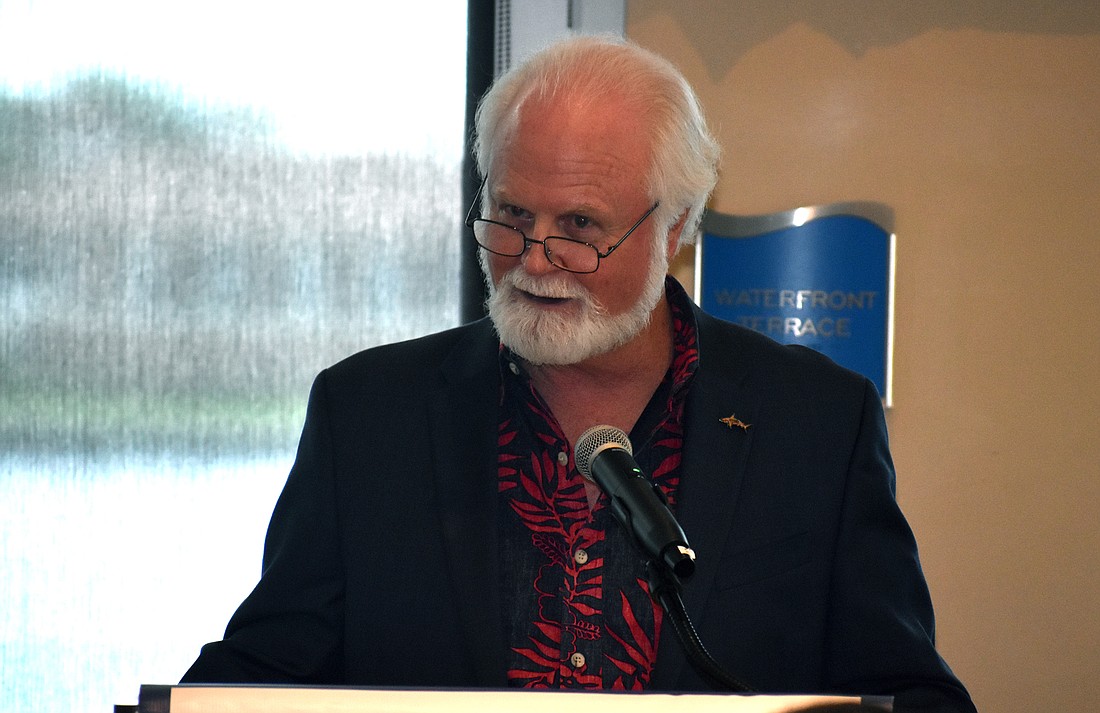- July 4, 2025
-
-
Loading

Loading

Mote Marine Laboratory and Aquarium President and CEO Michael Crosby has noticed that when red tide appears, state funding for research increases.
When red tide fades, so does the funding.
Regardless, Mote Marine Laboratory scientists are working on solutions to combat Karenia brevis, the toxic red algae bloom that has been in the Sarasota area since late July.
On Aug. 30, Crosby, along with a panel of scientists, including Vince Lovko, Tracy Fanara and Richard Pierce of Mote, and Alan Jones, president and owner of Jones Potato Farm, addressed a sold-out crowd of 200 at The Argus Foundation’s Meet the Minds luncheon.
Crosby opened the discussion explaining that everyone in the room understands the effects of red tide as most of them live in the area, and thus, are close to water. But there is something that a lot of people don’t understand, he said.
“But what is not as well understood is that we’re actually, in just this one disaster, experiencing two different, separate types of algal blooms,” Crosby said.
Florida is facing both a red tide bloom and a blue-green algal bloom. Crosby said he wanted to get everyone on the same page by saying that both types of algal blooms must have nutrients to survive and grow, and an excess in nutrients harm both freshwater and saltwater. The nutrients both blooms utilize come from both naturally occurring nutrient sources as well as from human activities.
However, the blooms are coming from different sources.
“The ongoing red tide bloom is a naturally occurring, cyclic event that is not initiated by the outflows from Lake Okeechobee, as opposed to the blue-greens nor the impacts of the Caloosahatchee River,” Crosby said.
Red time blooms develop as far away as 40 miles offshore in the Gulf of Mexico. When currents and winds move the red tide event closer to coastlines, the coastal communities and beaches experience the harmful impacts of those toxins.
“The red tide bloom is being fueled by a complex mixture of nutrients in marine waters all the way from offshore where they started all the way inshore to where the blooms are occurring now,” Crosby said.
Many of these sources, Crosby said, are from diverse coastal areas, including non-storm source runoff and inputs creeks and rivers that all carry the nutrient runoff from rainfall into the coastal ecosystems.
Crosby said that it is clear that excess land-based nutrients flowing into estuaries and coastal water in stormwater runoff to rivers and creeks exacerbate the growth of all harmful algal blooms.
“The bottom line is red tide is indeed naturally occurring. It is a phenomenon that existed long before Europeans ever arrived in Florida,” Crosby said. “The types of intense blooms that we are experiencing now, they’re not normal. This is not normal. Red tides do occur. That’s not abnormal, but what we’re experiencing now is not normal, but it’s also not unprecedented.”
In the 1800s, there was a decade long period where the area experienced red tide. In 1953, the area had an 18-month bloom. So while this bloom is bad, Lovko, Mote scientist and program manager of phytoplankton ecology, said, he reiterated that is it not unprecedented.
To clear red tide, Crosby said Mote scientists have been working tirelessly to find solutions. Most recently, Mote scientists designed and patented an ozone unit, so when scientists collect red tide-impacted saltwater from New Pass for its use in saltwater holding tanks, it goes in the chamber with high-energy ozone, which kills red tide, and in turn re-oxygenates the water. Early results look promising for a broader application, Pierce, associate vice president for research, senior scientist and program manager at Mote, said.
As the program closed, Crosby reiterated the issue of funding when asked what residents can do to help Mote. Crosby said that with proper funding, new technology to combat red tide can be invented.
“If we can’t show impacts in five years, shame on us,” he said.